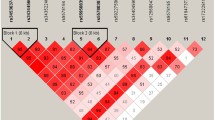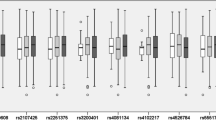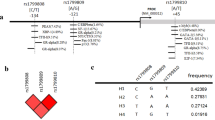Abstract
Stroke was regarded as a severe disorder with high morbidity and high mortality worldwide, ischemic stroke (IS) accounts for 85 to 90 % of new increased stroke cases. Partial mechanisms were elucidated by genetic factors including genomic instability such as single nucleotide polymorphism (SNP). Previous reports demonstrated that inflammation was involved in IS, NLRP3 [nucleotide-binding domain (NOD)-like receptor protein 3], acting as a specific inflammatory gene, however, its function and influence on IS was not well clarified. In this study, a case–control study including 1102 IS patients and 1610 healthy controls was conducted to investigate the association between IS susceptibility with a SNP (rs10754558) in 3′UTR of NLRP3. Logistic regression analysis showed that the heterozygote and the homozygote GG confer a significantly increased risk of CRC after controlling for other covariates (adjusted OR = 1.52, 95 % C.I. 1.19–1.97, P = 0.002; adjusted OR = 2.22, 95 % C.I. 2.18–3.67, P < 0.001, respectively). Carriage of G allele was associated with a greatly increased risk of developing the disease (OR = 1.69, 95 % C.I. 1.31–1.83, P < 0.001). Stratification analysis found that hypertension had interaction with rs10754558 to modulate IS risk. Further in vitro assay revealed that rs10754558 can affect mRNA level of NLRP3, suggesting its possible functional significance. Our data suggested that genetic polymorphisms in NLRP3 may influence IS risk in Chinese population. Replication of our studies in other populations and further functional studies are required for complete comprehension of the roles of NLRP3 polymorphisms in IS risk.

Similar content being viewed by others
References
Adams HPJ, Bendixen BH, Kappelle LJ et al (1993) Classification of subtype of acute ischemic stroke. Definitions for use in a multicenter clinical trial. TOAST. Trial of Org 10172 in Acute Stroke Treatment. Stroke 24(1):35–41
Adams HP Jr, Zoppo GD, Alberts MJ et al (2007) Guidelines for the early management of adults with ischemic stroke: a guideline from the American Heart Association/American Stroke Association Stroke Council, Clinical Cardiology Council, Cardiovascular Radiology and Intervention Council, and the Atherosclerotic Peripheral Vascular Disease and Quality of Care Outcomes in Research Interdisciplinary Working Groups. Stroke 2:29–36
Ahmad M, Dar NJ, Bhat ZS et al (2014) Inflammation in ischemic stroke: mechanisms, consequences and possible drug targets. CNS Neurol Disord Drug Targets 13(8):1378–1396
Dichgans M (2007) Genetics of ischaemic stroke. Lancet Neurol 6:149–161
Donnan GA, Fisher M, Macleod M, Davis SM (2008) Stroke. Lancet 371:1612–1623. doi:10.1016/S0140-6736(08)60694-7
Esenwa C, Gutierrez J (2015) Secondary stroke prevention: challenges and solutions. Vasc Health Risk Manag 7(11):437–450. doi:10.2147/VHRM.S63791
Fann DY, Lee SY, Manzanero S et al (2013) Pathogenesis of acute stroke and the role of inflammasomes. Ageing Res Rev 12(4):941–966
Feigin VL, Wiebers DO, Nikitin YP et al (1998) Risk factors for ischemic stroke in a Russian community: a population-based case-control study. Stroke 29(1):34–39
Feigin VL, Forouzanfar MH, Krishnamurthi R et al (2014) Global and regional burden of stroke during 1990–2010: findings from the Global Burden of Disease Study 2010. Lancet 383(9913):245–255. doi:10.1016/S2214-109X(13)70089-5
Gram AM, Frenkel J, Ressing ME (2012) Inflammasomes and viruses: cellular defence versus viral offence. J Gen Virol 93(10):2063–2075
Hata J, Matsuda K, Ninomiya T et al (2007) Functional SNP in an Sp1-binding site of AGTRL1 gene is associated with susceptibility to brain infarction. Hum Mol Genet 16:630–639
Hitomi Y, Ebisawa M, Tomikawa M et al (2009) Associations of functional NLRP3 polymorphisms with susceptibility to food-induced anaphylaxis and aspirin-induced asthma. J Allergy Clin Immunol 124(4):779–785.e6
Kamada AJ, Pontillo A, Guimarães RL et al (2014) NLRP3 polymorphism is associated with protection against human T-lymphotropic virus 1 infection. Mem Inst Oswaldo Cruz 109(7):960–963
Kristiina R, Jani L, Katariina Ö et al (2010) Cholesterol crystals activate the NLRP3 inflammasome in human macrophages: a novel link between cholesterol metabolism and inflammation. PLoS One 5(7):e11765. doi:10.1371/journal.pone.0011765
Kubo M, Hata J, Ninomiya T et al (2007) A nonsynonymous SNP in PRKCH (proteinkinase C eta) increases the risk of cerebral infarction. Nat Genet 39:212–217
Matarin M, Brown WM, Singleton A et al (2008) Whole genome analyses suggest ischemic stroke and heart disease share an association with polymorphisms on chromosome 9p21. Stroke 39:1586–1589. doi:10.1161/STROKEAHA.107.502963
Matarin M, Singleton A, Hardy J et al (2010) The genetics of ischaemic stroke. J Intern Med 267:139–155. doi:10.1111/j.1365-2796.2009.02202.x
Meschia JF, Brott TG, Chukwudelunzu FE et al (2000) Verifying the stroke-free phenotype by structured telephone interview. Stroke 31(5):1076–1080
Suárez R, Buelvas N (2015) Inflammasome: activation mechanisms. Invest Clin 56(1):74–99
Takahashi M (2014) Nlrp3 inflammasome as a novel player in myocardial infarction. Int Heart J 55(2):101–105
Tan MS, Yu JT, Jiang T et al (2013) NLRP3 polymorphisms are associated with late-onset Alzheimer’s disease in Han Chinese. J Neuroimmunol 265(1–2):91–95
Tong Y, Ding ZH, Zhan FX et al (2015) The NLRP3 inflammasome and stroke. Int J Clin Exp Med 8(4):4787–4794
Walsh PS, Metzger DA, Higushi R (1991) Chelex 100 as a medium for simple extraction of DNA for PCR-based typing from forensic material. Biotechniques 10(4):506–513
Yamada Y, Fuku N, Tanaka M et al (2009) Identification of CELSR1 as a susceptibility gene for ischemic stroke in Japanese individuals by a genome-wide association study. Atherosclerosis 207:144–149
Zhang HX, Wang ZT, Lu XX et al (2014) NLRP3 gene is associated with ulcerative colitis (UC), but not Crohn’s disease (CD), in Chinese Han population. Inflamm Res 63(12):979–985. doi:10.1007/s00011-014-0774-9
Zhao Y, Lina Z, Ronghua X et al (2015) MicroRNA-223 regulates inflammation and brain injury via feedback to NLRP3 inflammasome after intracerebral hemorrhage. Mol Immunol 65:267–276. doi:10.1016/j.molimm.2014.12.018
Acknowledgments
This study is supported by grants from Natural Science Foundation of China (No. 81502428), Natural Science Foundation of Jiangsu Province (No. BK20140222, No. 15KJB310024, No. BK20150220), Xuzhou Medical College scientific research fund for talents (No. D2015018 to Zhansheng Zhu, and No. D2015019 to Huiping Wang).
Author information
Authors and Affiliations
Corresponding author
Ethics declarations
Conflict of Interest
The authors declare that they have no conflict of interest.
Rights and permissions
About this article
Cite this article
Zhu, Z., Yan, J., Geng, C. et al. A Polymorphism Within the 3′UTR of NLRP3 is Associated with Susceptibility for Ischemic Stroke in Chinese Population. Cell Mol Neurobiol 36, 981–988 (2016). https://doi.org/10.1007/s10571-015-0288-1
Received:
Accepted:
Published:
Issue Date:
DOI: https://doi.org/10.1007/s10571-015-0288-1




